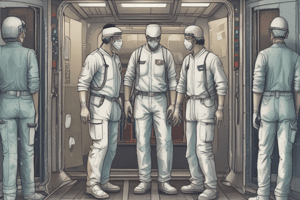Podcast
Questions and Answers
What is the definition of hemoptysis?
What is the definition of hemoptysis?
- Coughing up blood (correct)
- Blood in urine
- Spitting out phlegm
- Excessive vomiting
Which of the following is a sign of compromised breathing adequacy?
Which of the following is a sign of compromised breathing adequacy?
- Active wheezing
- Pale skin
- Increased heart rate
- All of the above (correct)
What does guarding typically indicate in a patient?
What does guarding typically indicate in a patient?
- Underlying pain or discomfort (correct)
- A state of collapse
- Extreme alertness
- Physical weakness
Which method best describes the process of checking a patient's mental status?
Which method best describes the process of checking a patient's mental status?
What does the term 'flail chest' refer to?
What does the term 'flail chest' refer to?
What is a common sign of CHF (Congestive Heart Failure)?
What is a common sign of CHF (Congestive Heart Failure)?
When should a tourniquet be applied?
When should a tourniquet be applied?
What is a key distinguishing factor between compensated and decompensated shock?
What is a key distinguishing factor between compensated and decompensated shock?
What is the primary difference between an AMI and angina?
What is the primary difference between an AMI and angina?
Which treatment is appropriate for a patient experiencing wheezing?
Which treatment is appropriate for a patient experiencing wheezing?
Which of the following is a sign of respiratory distress?
Which of the following is a sign of respiratory distress?
What is the correct CPR compression-to-breath ratio for an adult?
What is the correct CPR compression-to-breath ratio for an adult?
What should be done when splinting an extremity with a suspected fracture?
What should be done when splinting an extremity with a suspected fracture?
Which type of shock is characterized by a loss of blood volume?
Which type of shock is characterized by a loss of blood volume?
What is the main indication for using nitroglycerin?
What is the main indication for using nitroglycerin?
What is the purpose of the Rule of Nines in assessing burns?
What is the purpose of the Rule of Nines in assessing burns?
Flashcards
Hypoxia
Hypoxia
A condition where the body's tissues don't receive enough oxygen.
Seizure
Seizure
A sudden, temporary disturbance in brain function caused by abnormal electrical activity in the brain.
Angina
Angina
A blockage or narrowing of a coronary artery, causing chest pain.
AMI (Acute Myocardial Infarction)
AMI (Acute Myocardial Infarction)
Signup and view all the flashcards
Upper GI Bleed
Upper GI Bleed
Signup and view all the flashcards
Lower GI Bleed
Lower GI Bleed
Signup and view all the flashcards
Circulatory System
Circulatory System
Signup and view all the flashcards
Splinting
Splinting
Signup and view all the flashcards
Placenta previa
Placenta previa
Signup and view all the flashcards
Placenta abruptio
Placenta abruptio
Signup and view all the flashcards
Hematemesis
Hematemesis
Signup and view all the flashcards
Hemoptysis
Hemoptysis
Signup and view all the flashcards
Hematuria
Hematuria
Signup and view all the flashcards
Congestive heart failure (CHF)
Congestive heart failure (CHF)
Signup and view all the flashcards
Signs and symptoms of coronary artery disease
Signs and symptoms of coronary artery disease
Signup and view all the flashcards
Study Notes
Mechanism of Injury (MOI) vs. Nature of Injury (NOI)
- Understanding MOI and NOI is crucial for assessing injuries.
Hypoxia Definition
- Definition of hypoxia is needed.
HIV and Hepatitis Prevention
- Knowledge of how to prevent HIV and hepatitis transmission is essential.
Acute Myocardial Infarction (AMI) vs. Angina
- Differentiating between AMI and angina symptoms is crucial.
Seizure Types and Steps
- Knowing the different types of seizures and the steps to take during a seizure are important.
Upper and Lower GI Bleeds
- Recognizing signs and symptoms of upper and lower gastrointestinal bleeds is crucial.
Circulatory System Passageways
- Understanding the path of blood flow through the circulatory system is important.
Splinting Procedures
- Knowing the steps for splinting procedures, including pulse checks before and during splinting, is vital.
Oropharyngeal (OPA) vs. Nasopharyngeal (NPA) Airways
- Understanding the indications and contraindications for using OPA and NPA airways.
Respiratory Distress Signs
- Recognizing the signs and symptoms of respiratory distress and knowing the different sounds is important.
Rule of Nines
- Knowing the rule of nines for calculating burn areas.
Epistaxis Definition and Management
- Defining epistaxis and explaining its treatment.
Wheezing Treatment
- Understanding the treatment of wheezing.
Cardiopulmonary Resuscitation (CPR) Rates and Ratios
- CPR rates and ratios for different age groups and situations.
Cold-Related Emergency Treatments
- Treatment of cold-related emergencies and differentiating localized from generalized emergencies, and conscious vs unconscious situations
Hypothermia and Hyperthermia Treatment
- Treatment protocols for hypothermia and hyperthermia.
Spinal Column Anatomy and Injuries
- Understanding the parts of the spinal column and associated injuries.
Fontanelle Definition
- Defining fontanelles.
Splinting Protocols and Position of Function
- Knowledge of when to splint, what to include in the splint and positioning to maintain function.
Epiglottitis, Croup, and Meningitis: Signs, Symptoms, and Treatments
- Signs, symptoms, causes, and treatments of epiglottitis, croup, and meningitis.
Stroke Types and Treatment
- Different types of strokes, their signs, symptoms, and treatments.
Active Stroke and Seizure Treatment
- Treatment for active stroke and seizures.
Insulin Function and Deficiency
- Mechanism of insulin's function and what happens if a person's body lacks insulin.
Thrombolytic Therapy (tPA and rPA)
- Knowledge of the use of thrombolytic therapy like tPA and rPA, and what to expect during procedures
Anaphylaxis Signs, Symptoms, Causes, and Treatments
- Knowledge of the symptoms, causes and treatment of anaphylaxis.
Dysuria Definition
- Defining dysuria.
Dysphagia Definition
- Defining dysphagia.
Dyspnea Definition
- Defining dyspnea
Child and Elderly Abuse Reporting
- Recognizing signs and symptoms of child and elderly abuse and knowing when to report them.
Shock Types and Treatments
- Types of shock, their signs, symptoms, and treatments.
Wheezing Causes and Treatments
- Understanding the causes of wheezing and how to treat them.
Airway Procedures
- Performing airway procedures, such as helmet removal, and the proper use of nitroglycerin.
Internal vs. External Bleeding Control
- Knowing the difference between internal and external bleeding and the methods for controlling each.
Triage Tagging and Transport Order
- Understanding the triage tagging process and the order of patient transport.
Cardiac Tamponade, Commotio Cordis, Hyper/Hypoglycemia Treatments
- Identifying the nature of cardiac tamponade, commotio cordis, and hyper/hypoglycemia, and knowing its treatments.
Abdominal Pain and Seizure Types
- Knowing about abdominal pain management and treatment of seizure types.
Childbirth and Placenta Steps and Definitions
- Procedures in child delivery, placenta definition, and related conditions like preeclampsia, eclampsia, and placenta previa
Placenta Abruptio Definition
- Defining placenta abruptio.
Chest Compression Sites for Various Age Groups
- Chest compression sites for different age groups.
Hematemesis, Hemoptysis, and Hematuria Definitions
- Defining hematemesis, hemoptysis, and hematuria.
Congestive Heart Failure (CHF) and Coronary Artery Disease Signs and Symptoms
- Signs and symptoms of CHF and coronary artery disease.
Gastric Distention, Emphysema, Asthma Definitions
- Definitions of gastric distention, emphysema, and asthma, alongside their signs and symptoms.
Pneumonia, Chronic Bronchitis, and Common Injuries by Age Group
- Knowing the signs, symptoms, and treatments for pneumonia and chronic bronchitis and treatment for common injuries by age group
Hypothermia Emergency Steps and Heat Loss Methods
- Steps and methods of treatment during a hypothermia emergency and the methods of heat loss are essential to know.
Ventilatory Rates for Different Age Groups
- Understanding the ventilatory rates for different age groups is vital.
Knowledge of PPE Use in Medical Situations
- Knowing proper personal protective equipment (PPE) for various medical situations, such as OB, TB, and bleeding scenarios
Carbon Monoxide Danger
- Understanding the dangers of carbon monoxide.
Breathing/Respiratory Issues Assessments
- Assessment of breathing and respiratory issues and indications for intubative treatment
Head Injury Assessments, Mnemonic STOPPED
- Assessment guidelines for head injuries and importance of using mnemonic STOPPED.
Mental Status Assessments and Baseline Vitals Significance
- Knowledge to assess mental status, and importance of taking baseline vitals.
Epinephrine Dosage, Normal Breathing Stimuli, KED vs. Rapid Extrication
- Epinephrine dosage, normal breathing mechanisms, and differentiating KED from rapid extrication.
Referred Pain, Phantom Pain, Rebound Tenderness Distinction
- Differentiating between referred pain, phantom pain, and rebound tenderness.
Pregnancy Position and Delivery Complications
- Recognizing the importance of pregnancy position for deliveries and associated possible complications.
Compensated vs. Decompensated Shock and Pneumothorax Types
- Assessing compensated vs decompensated shock and distinguishing between types of pneumothorax
Flail Chest Definition and Treatment
- Importance of understanding flail chest definition and how to treat
Tourniquet Use, Hazmat Precaution
- Importance of understanding tourniquet application. Precaution during hazmat emergencies.
Neonatal Resuscitation, Bite/Sting/FB Treatments and Stroke Assessments
- Procedures for neonatal resuscitation. Treatment for bites/stings/foreign body obstruction (FBO). Assessing stroke patients for treatment.
Ligament vs. Tendon Distinction
- Knowing the difference between ligaments and tendons.
Eye Injury Treatment
- Treatment for eye injuries.
Good Luck Message
- A good luck message.
Studying That Suits You
Use AI to generate personalized quizzes and flashcards to suit your learning preferences.




